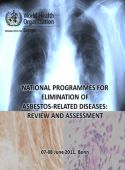National programmes for elimination of asbestos-related diseases: review and assessment

Download
The WHO European Centre for Environment and Health (Bonn) convened a meeting of representatives of the selected Member States and international experts for cooperative implementation of the Parma commitment regarding asbestos control in June 2011.
A short survey carried out by WHO before the meeting showed that, out of 53 Member States of the WHO European Region, more than 30 countries banned all types of asbestos as of 2011. Country situations of asbestos control policies were presented according to the format provided by the WHO. In the EU Member States, the use of all forms of asbestos was banned in the 1990’s and early 2000’s. Participants recognized that the awareness of asbestos hazards and policies on asbestos control were weak in the newly independent states of the former Soviet Union and the South-eastern European countries, in contrast to the EU Member States. The viewpoints of patients, workers and medical professionals on the international asbestos control policies were discussed.
The meeting made conclusions and recommendations for the development of the national programmes for the elimination of asbestos-related diseases which include further steps and milestones of cooperative implementation of the Parma commitments regarding asbestos policy development. Useful information for the policy-makers of the Member States presented at the meeting by the WHO temporary advisers, e.g., scientific evidence on the causal association between the chrysotile asbestos and asbestos-related diseases, the recommendations of WHO and ILO for the elimination of asbestos-related diseases, and a review of safer substitutes for asbestos materials, are enclosed as annexes in this meeting report.



